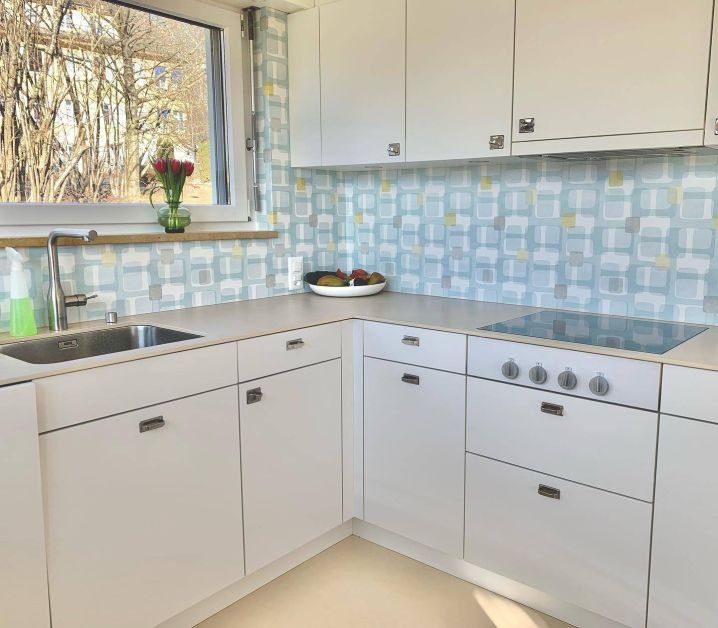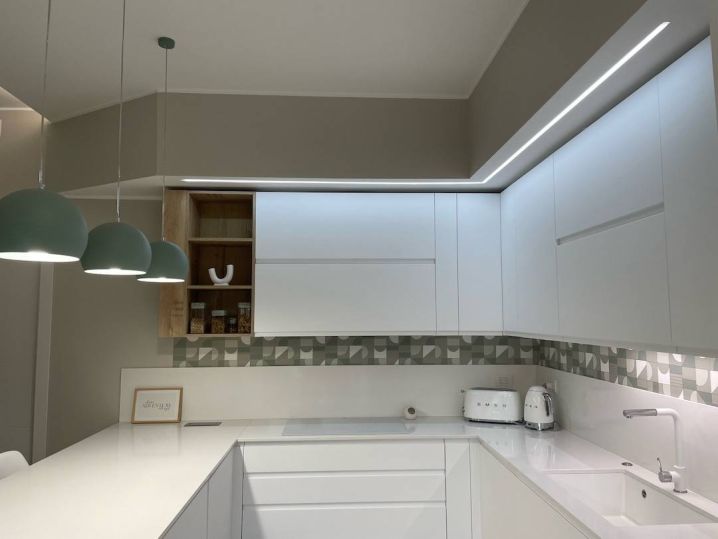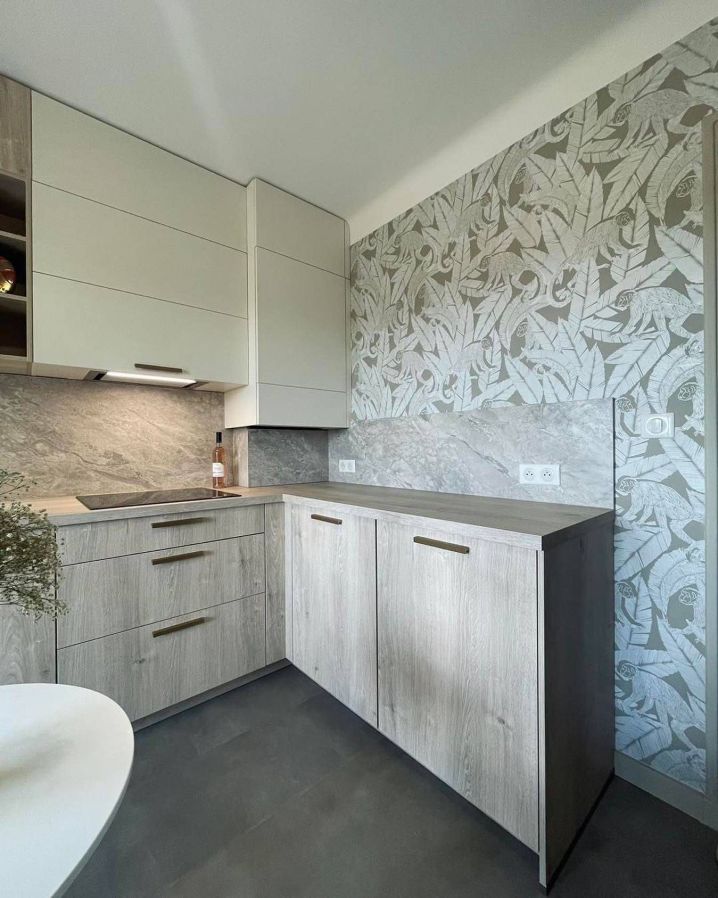Can I wallpaper my kitchen backsplash?
we renovated our kitchen a few years ago. It still looks fine and it’s perfectly functional, but it lacks character. It just looks like a sterile kitchen from a catalogue, and I want to give it a bit more personality. One of the areas I would like to work on is the backsplash and I was wondering: is it possible to wallpaper it? How can I make sure the surface is not immediately damaged by spills and food landing on it while we cook? Is it feasible or should I just forget it?
Thank you in advance!
Malthe
Aarhus, Denmark
Dear Malthe,
I understand your worries and concerns as the backsplash is definitely a part of the kitchen that sees a lot of action. While its primary function is to protect your kitchen walls from splashes, stains, and general cooking-related mess, it is also a crucial element in kitchen design. It is not inconceivable to wallpaper them - in fact, this is a trend we have seen more of in recent years. However, if this is your plan, there’s a number of points you should consider beforehand. Let’s look at them in detail:
Is wallpapering the kitchen backsplash wall an option?
Backsplashes are especially important around the sink and stove, where spills and splashes are common occurrences. Being so prominent, they are also a terrific way to introduce colours and patterns complementing your kitchen design, just as long as you use the right wallpaper material and take some precautions. Modern wall décor is no longer as delicate and easily damaged as it used to be, and many models are now made from durable, washable materials able to withstand the rigours of a kitchen environment. However, one of the most compelling aspects of this approach is its affordability compared to tiles or stone, especially when considering the higher costs in terms of both material and installation.

What should I consider when selecting a wallpaper for my kitchen backsplash?
As the kitchen is a far harsher environment than a bedroom or a living room, you need to consider characteristics that go beyond the purely esthetical aspect when it comes to selecting the right wallpaper. Kitchens are humid spaces, prone to oily spills and splashes, so you should opt for models that are water-resistant and can withstand cleaning with a damp cloth while also being mould- and mildew-resistant.
- Check wallpaper details provided by vendors
You know all those specifications provided by wallpaper vendors for each model? You should pay close attention to what they say, as they often include information about a wallpaper's suitability for specific areas, including kitchens. - Consider factors specific to your own kitchen
Not all kitchens are the same and not everyone uses the kitchen in the same way. Small kitchens with small windows tend to create more humidity than langer ones. If you are an avid cook who frequently prepares meals that involve steam or splattering, you will need to protect the backsplash more efficiently than someone who only cooks sporadically.
Which wallpaper types are suitable for a backsplash?
When it comes to picking a wallpaper for your backsplash, the choice is limited to the following options:
- Vinyl wallpaper
Vinyl wallpaper is without a doubt my top choice for kitchen backsplashes. It is exceptionally durable and can withstand the everyday wear and tear that the kitchen environment often brings. Splatters, stains, and the occasional bump are no problem for good old vinyl wallpaper; you can just wipe that fatty Bolognese sauce stain off without worrying. Its resistance to moisture means that it can handle the elevated humidity levels of boiling water without warping or peeling. - Non-woven wallpaper
Besides vinyl, there is another type of wallpaper material that can be considered for a backsplash. Non-woven wallpapers are made from a mixture of synthetic and natural fibres that can be easily cleaned with water and mild detergents. While suitable for general kitchen use, some of them might not be able to cope with hot, fatty stains. If you frequently cook deep-fry dishes or other recipes that involve hot oil or butter, it might be a good idea to add an extra coat of sealant or protecting the backsplash with a glass panel. - Peel-and-stick wallpaper
If you're a DIY novice or simply looking for an option that doesn’t require much effort, the increasingly popular peel-and-stick wallpaper types can be a suitable choice. Designed with ease of installation in mind, these models are also made of non-woven material but feature a self-adhesive backing layer, eliminating the need for extra adhesive or wallpapering paste. No tool is required, you simply peel off the backing and stick the wallpaper directly to your backsplash area. To find out more about them, check our “Peel-and-stick FAQ”.
Which wallpaper types should I NOT consider as backsplash wallpaper?
Some wallpaper materials are absolutely not suitable to be used for backsplashes. They include:
- Textile wallpaper
Made from natural fibres like silk, linen, or cotton, textile wallpaper models are not suitable due to their vulnerability to stains. Textile wallpapers are porous and can absorb moisture, leading to warping and deterioration over time. They are difficult to clean effectively, so they are a no-go for backsplashes. - Textured wallpaper
While highly textured wallpapers may be a captivating element in other parts of your home, I cannot recommend them when it comes to kitchen backsplashes. Their textures trap dirt and grease, making them difficult to clean and maintain in an acceptable state. - Non-washable wallpaper
Constantly subjected to spills and splatters, few places in the kitchen require more regular cleaning than a backsplash. Non-washable wallpapers are not designed for such an environment: attempting to clean them with water or mild detergents causes damage as they are not equipped to withstand moisture.
What should I consider before installing wallpaper on my backsplash wall?
Before you start installing wallpaper on your backsplash wall, there are a few considerations to keep in mind to ensure a successful and visually pleasing result:
- Evaluate the backsplash surface
Before you even begin to consider wallpapering your backsplash, check the surface carefully to determine whether it is suitable for wallpaper. Your backsplash should be relatively smooth and free of major imperfections. The surface should be clean and dust-, grease-, and residue-free. - Ensure the surface is in good condition
Wallpaper can emphasise imperfections in the wall. Repair any cracks, holes, or damage on the backsplash surface. Make sure there are no signs of mould, water damage, or leaks as this can lead to the wallpaper peeling off or developing air bubbles. - Textured or uneven walls can pose a challenge
Wallpaper adheres best to smooth, flat surfaces, so if your wall has textures or uneven areas, it's advisable to address these issues before proceeding with the wallpapering process. Use a filler or putty to fill in gaps and imperfections, followed by sanding to create a more even surface. Remember that peel-and-stick wallpapers are even less suitable for textured walls; if your surface is not smooth, using them will result in a finish you might not be happy with. - Steps to take if the surface is already painted
If your backsplash wall is already painted, especially if the paint is glossy or has a sheen, I highly recommend you use a primer to create a suitable surface for the wallpapering paste to bond properly. For more on this topic, refer to our instructions “Applying deep primer or thinned wallpapering paste”.

On which wall type can I install wallpaper as a kitchen backsplash?
Any kitchen backsplash decoration project must start with checking which type of material your backsplash is made of and its actual state. Different wall types require different approaches: while drywalls are easy to wallpaper, if your backsplash is made of plywood/MDF or if it is tiled you might first need to sand the surface or apply a coat of primer.
Can I install a backsplash wallpaper on a drywall?
Drywall is a versatile material found in most interior walls, including kitchen backsplashes. It is easy to work with, making it a practical choice if you want to install a wallpaper on it. Its surface should be clean, cracks-free and dry. Avoid cooking close to the surface for at least 24 hours before starting the installation. For more in-depth instructions, please check our instructions article “Do you need to prime drywall before wallpapering?”.
Can I install a backsplash wallpaper on a plaster wall?
Backsplash plaster walls can be an excellent surface for wallpaper application, as long as they are prepped correctly. Like for drywall, first of all assess the condition of the plaster and make sure it has no cracks or imperfections, as plaster can age poorly. Due to its porous nature, it is a good idea to prime it first. This creates a suitable surface for the adhesive to bond with and prevents the plaster from absorbing the paste too quickly. Read more about this topic in my reply to the question “How to prepare the wallpapering surface”.

My kitchen backsplash is made of MDF, can I install a wallpaper on it?
A number of kitchen backsplashes are made of MDF (Medium-Density Fibreboard). If this is the case, the good news is that yes, it is possible to wallpaper on it. Surface smoothness is essential for a successful project, so check for cracks and fill them before starting the wallpapering process. Like all wood surfaces, MDF tend to quickly absorb wallpapering paste. For this reason, I highly recommend priming its surface to help improve adhesion.
Can I wallpaper the woodchip backsplash of my IKEA kitchen?
Combining a very competitive price with modern, appealing design and functionality, it is no surprise that IKEA kitchens are extremely popular. Almost all furniture from the Swedish giant is woodchip pressed between plastic veneer. Normal wallpapering paste doesn’t adhere well to these plastic surfaces, so you will need something stronger. Dispersion adhesive comes to the rescue! This is a resin-based adhesive that can either be added to standard glue to increase its adhesive strength or used on its own. Uncoated woodchip backsplash surfaces are less common these days and wallpapering them can be challenging as the texture will show through. Installing a thick, 1400-grade lining paper will cover all manner of lumps and bumps, but you need to make sure that your woodchip surface is still in good condition. If your backsplash is already decorated with woodchip wallpaper, you can find all the information you need in my answer to the question “Can I wallpaper over woodchip wallpaper?”.
I have a panelled backsplash; can I wallpaper over it?
Wood panels can certainly be wallpapered, as long as the surface is properly prepped. As panels typically have grooves or seams, you will first need to fill these in. Once that is done, you will need to sand the panelling to create a flat and even surface. Applying a wallpaper primer to the panelling is essential as this not only improves adhesion but also creates a barrier that prevents it from absorbing the wallpaper adhesive too quickly. Read about this in more detail in my answer to the question “Can I wallpaper over wood panelling?”.
My kitchen backsplash area is a brick wall, can I wallpaper it?
As brick walls tend to be quite textured, you need to take some steps to create a flatter surface that guarantees a smoother finish. You will need to apply a thin layer of drywall compound or at least a standard filler - which you can buy in any DIY store - to even out the surface (which will need to be sanded once dry). If you feel the surface is still not flat enough, put up lining paper before proceeding with the wallpaper installation. If you are unsure about what lining paper really is, you can check my answer to the question “What is lining paper?”. Sealing the surface with a coat of primer or diluted wallpaper glue is also a good idea, as this ensures that the adhesive is evenly absorbed.
My backsplash is already tiled, can I wallpaper over it?
Tiles are a very common as a backsplash surface. They are robust and fairly easy to clean, but one can get easily bored of their look. If you are considering a change, you’ll be pleased to know that yes, it is possible to wallpaper over tiles. First of all, you will need to fill the grooves and grouting between the tiles, otherwise your wallpaper won’t stick. Once this is done, you’ll have to sand the surface to make it even and less glossy. Clean it thoroughly with a soapy solution and apply a primer. For an in-depth look, refer to my answer to the question “Can I wallpaper over tiles?”.
Should I protect my backsplash wallpaper with an extra coat of varnish?
The primary purpose of applying protection or sealant to your backsplash wallpaper is to enhance its durability and protect it from moisture, stains, and daily wear and tear. This extra layer acts as a shield, ensuring that your wallpaper remains in great condition over the years. An extra coat of varnish is recommended for any non-vinyl wallpaper in areas close to the sink and the hob, as it makes them washable while also providing some protection against oily spills. I suggest this extra step in the following cases:
- High-humidity kitchens
If there are elevated moisture levels in your kitchen (for instance because it’s very small or without sufficient aeration) then using an extra coat of sealant will help protect the wallpaper from moisture-related damage, particularly near to the cooking and sink area. - Frequent splatters or spills
If your cooking area sees frequent spills and splatter because you like to pan-fry food, cook delicious sauces etc., then the extra level of protection provided by a coat of varnish will help maintain your wallpaper in mint condition.
Which sealant should I choose to add extra protection to my backsplash wallpaper?
If you decided to add a coat of sealant, choose a product specifically designed for this purpose. Look for options that are clear, non-yellowing, and suitable for your wallpaper of choice. Always carefully follow the manufacturer's instructions for application. For more information on this topic, head for our in-depth article “How to seal wallpapers to make them dirt-repellent and washable”.

Can I protect my backsplash wallpaper with glass?
You certainly can, and I personally think it’s worth the effort. A protective glass panel hugely widens your options when it comes to pick a design, as you won’t be restricted to a few selected materials. Nothing beats glass in terms of protection as anything that lands on it can simply be wiped off. The type of glass and the installation method plays an important role: if you want to make the glass truly disappear from sight, you need to have thin glass custom-cut to fit the dimensions of your backsplash. You don’t want to see any glue on the wallpaper or some ugly mounting, so instead use tiny beads of epoxy on the glass edge at the worktop and ceiling.
How can I remove existing wallpaper from my backsplash wall?
If you’ve already installed a backsplash wallpaper in your kitchen and are looking to update the design with a new model, I strongly recommend you first remove the existing wall décor (means not to hang on top of the old wallpaper). How to proceed depends on the type of material your backsplash as well as the existing wallpaper are made of. I covered this in detail in the following instructions: “How to strip old wallpaper”.
How do I maintain my backsplash wallpaper in good condition?
As long as you have picked the right wallpaper material and made sure it is properly sealed, your backsplash wallpaper should look great for a long time. To maintain it in pristine condition, I would recommend two simple maintenance steps:
- Maintain proper ventilation in the kitchen
If it gets too steamy, make sure you open the windows and use the exhaust fan to help reduce the buildup of humidity and grease, which can contribute to staining and damage your wallpaper. - Clean your backsplash wallpaper immediately
If you notice that a fresh stain or spill has landed on your wallpaper, don’t let it sit there for hours. Address it promptly by blotting the affected area gently with a clean, dry cloth to absorb excess moisture. Avoid rubbing, as it can spread the stain.
Your wallpaper expert
Isabel
Further questions
- What does “paste the wall” mean? Martina13 October 2023
- How do I wallpaper a chimney breast? Alfhild12 March 2024
- Do you need to prime plaster walls before wallpapering? Cameron5 January 2024
- Can I wallpaper over woodchip wallpaper? Pierre23 January 2024
- Is it possible to use wallpaper in tropical climates? Abigail15 February 2024
